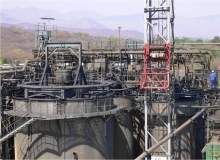
Used in building construction, power generation, consumer electronics and nutritional supplements, copper is an integral part of our lives, and demand for the multipurpose metal is only continuing to increase.
What’s worrying, though, is that this rising demand is currently not being met by supply. Indeed, according to preliminary data from the International Copper Study Group (ICSG) for 2012, world demand for refined copper is expected to exceed production of the substance by about 240,000 metric tons, making this year the third consecutive year of production deficit.
This is largely because high-grade copper sites have become increasingly scarce; where, in the past, deposits were known to contain as much as 30% copper, many sites now have concentrations of only one percent. Although this is hardly surprising given the fact that man has been mining for the material for centuries, it does pose a huge problem: without high-grade copper sites, conventional mining methods are becoming too expensive to use.
Traditional techniques involve crushing and grinding copper-containing ore, followed by applying a tremendous amount of heat or toxic chemicals. As these processes are often energy-intensive, and therefore costly, they are only used on high-grade sites; it’s just not worth it in areas where the concentration of copper is classified as ‘low-grade’.
But biotechnologists have come up with an interesting solution: mineral-munching microbes, or as the process is more commonly known, bioleaching. Essentially, it works by using microbes to break down minerals from low-grade copper sites, thereby improving recovery rates and reducing costs, and it’s so effective that dump and heap bioleaching of secondary copper ores and mixed oxide / sulphide ores are now estimated to represent 20-25% of the world’s copper production.
"As ore grades in mineral resources are declining, low-cost technologies that allow the extraction of metals from low-grade ores are becoming increasing important," says Dr Anna Kaksonen, a senior research scientist specialising in mining biotechnology at Australia’s Commonwealth Scientific and Industrial Research Organisation (CSIRO).
Bioleaching: the basics
But just how does this increasingly widespread mining method work?
"Bioleaching has been mainly used to solubilise metals from sulphide ores with the help of Fe2+ and sulphur oxidising microorganisms," Kaksonen explains.
"In this process the microbes gain energy from Fe2+ and sulphur oxidation and produce Fe3+ and sulphuric acid, which attack the sulphide minerals leading to the solubilisation of base metals, such as copper, nickel and zinc.
"The same microorganisms can also be used to oxidise sulphidic ores which contain gold or silver. In biooxidation, the undesired metal sulphide matrix is dissolved, making the solid gold or silver more available for leaching using other methods."
The extraction rate of bioleaching depends on a variety of factors: the applied technology (such as bioreactors, heap, dump or in situ application); the mineral composition of the ore (for example, chalcocite is bioleached more readily than chalcopyrite); the particle size of the ore; the percentage of the desired minerals available for solubilisation versus the percentage which is locked within the non-soluble matrix; the operation conditions (for example, the pH or the temperature); the possible inhibitory compounds that may be solubilised from the ore; the microbial density, activity and diversity; and the treatment time.
Yet, in general terms, the amount of copper extracted using this process has unquestionably been impressive.
"For heap operations, copper extraction yields have been reported to range from approximately 35% to 80%, whereas in some bioreactor processes, recoveries of as high as 98% have been reported," Kaksonen notes. "Biotechnology has the potential to transform an uneconomic resource into a reserve."
Slow and steady wins the race
Although bioleaching processes, such as heap or in situ leaching, take a relatively long time in comparison to conventional leaching methods, and the residues from bioleaching need to be managed to prevent metal mobilisation and acid generation after the metal recovery has been completed, the advantages of the technology far outweigh its drawbacks.
One of the most attractive things about bioleaching is its low capital and operating costs. "Bioleaching can be attractive for low grade ores that are too expensive to process using conventional processes or where smelters impose penalty rates because of hazardous emissions – for example, if there is more than 0.15% arsenic in the material," Kaksonen confirms.
Moreover, while traditional mining methods use relatively high temperatures, bioleaching processes operate at ambient pressures and relatively low temperatures, as well as using naturally occurring organisms.
As the bacteria use air, mainly oxygen and CO2, and the mineral itself as a source of energy, they need very little extra stimulation to do their work. Indeed, if left alone, the micro-organisms, which are harmless to both humans and the environment, would, during hundreds of years, eventually extract the copper from the ores all on their own.
Other applications: future of biomining
Looking to the future, the ICSG has estimated that in 2013, increased output from new and existing mines could reverse the three-year trend of demand exceeding supply. Indeed, based on initial projections, refined copper production could exceed demand by around 350,000 tons.
Biomining no doubt has a key role to play in this trend, but that’s certainly not all the scientists who are researching the technology hope to achieve. Microbes can also be used to extract gold and uranium, among other metals, and, in the future, could potentially be instrumental in making the lifecycle of minerals significantly more sustainable.
"Until now, biomining has mostly focused on the treatment of sulphide ores using oxidation processes, but recent research show that microbes could potentially also be used for the processing of oxide ores, such as laterites, through reductive bioleaching mechanism," Kaksonen says.
"Moreover, ore pre-treatment methods such as bioflotation and bioleaching of impurities are currently under development and may allow the utilisation of more complex ores. Additionally, the application of bioleaching to recover metals from various metal-containing waste materials is being explored to make the overall lifecycle of the mineral resources more sustainable."



